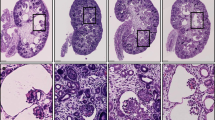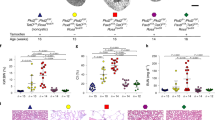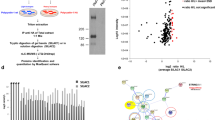Abstract
Autosomal dominant polycystic kidney disease (ADPKD) describes a group of at least three genetically distinct disorders with almost identical clinical features1–6 that collectively affects 1:1,000 of the population7. Affected individuals typically develop large cystic kidneys and approximately one half develop end-stage renal disease by their seventh decade. It has been suggested that the diseases result from defects in interactive factors involved in a common pathway. The recent discovery of the genes for the two most common forms of ADPKD has provided an opportunity to test this hypothesis5,6,8–10. We describe a previously unrecognized coiled-coil domain within the C terminus of the PKD1 gene product, polycystin, and demonstrate that it binds specifically to the C terminus of PKD2. Homotypic interactions involving the C terminus of each are also demonstrated. We show that naturally occurring pathogenic mutations of PKD1 and PKD2 disrupt their associations. We have characterized the structural basis of their heterotypic interactions by deletional and site-specific mutagenesis. Our data suggest that PKD1 and PKD2 associate physically in vivo and may be partners of a common signalling cascade involved in tubular morphogenesis.
This is a preview of subscription content, access via your institution
Access options
Subscribe to this journal
Receive 12 print issues and online access
$209.00 per year
only $17.42 per issue
Buy this article
- Purchase on Springer Link
- Instant access to full article PDF
Prices may be subject to local taxes which are calculated during checkout
Similar content being viewed by others
References
Peters, D.J.M. & Sandkuijl, L.A. Genetic heterogeneity of polycystic kidney disease in Europe. In Polycystic Kidney Disease. Contrib. Nephrol. (eds Breuning, M.H., Devoto, M. & Romeo, G.) 128–139 (Karger, Basel, 1992).
Bogdanova, N. et al. Genetic heterogeneity of polycystic kidney disease in Bulgaria. Hum. Genet. 95, 645–650 (1995).
Daoust, M.C., Reynolds, D.M., Bichet, D.G. & Somlo, S. Evidence for a third genetic locus for autosomal dominant polycystic kidney disease. Genomics 25, 733–736 (1995).
De Almeida, S. et al. Autosomal dominant polycystic kidney disease — evidence for the existence of a third locus in a Portuguese family. Hum. Genet. 96, 83–88 (1995).
The European Polycystic Kidney Disease Consortium. The polycystic kidney disease gene encodes a 14 kb transcript and lies within a duplicated region on chromosome 16. Cell 77, 881–894 (1994).
Mochizuki, T. et al. PKD2, a gene for polycystic kidney disease that encodes an integral membrane protein. Science 272, 1339–1342 (1996).
Gabow, P.A. Autosomal dominant polycystic kidney disease. N. Engl. J. Med. 329, 332–342 (1993).
American PKD1 Consortium. Analysis of the genomic sequence for the autosomal dominant polycystic kidney disease (PKD1) gene predicts the presence of a leucine-rich repeat. Hum. Mol. Genet. 4, 575–582 (1995).
The International Polycystic Kidney Disease Consortium. Polycystic kidney disease: the complete structure of the PKD1 gene and its protein. Cell 81, 289–298 (1995).
Hughes, J. et al. The polycystic kidney disease 1 (PKD1) gene encodes a novel protein with multiple cell recognition domains. Nature Genet. 10, 151–160 (1995).
Lupas, A., Van Dyke, M. & Stock, J. Predicting coiled-coils from protein sequences. Science 252, 1162–1164 (1991).
Cohen, C. & Parry, D.A.D. α-Helical coiled coils — a widespread motif in proteins. TIBS 11, 245–248 (1986).
Cohen, C. & Parry, D.A.D. α-Helical coiled coils: more facts and better predictions. Science 263, 488–489 (1994).
Dhand, R. et al. PI 3-kinase: structural and functional analysis of intersubunit interactions. EMBO J. 13, 511–521 (1994).
Fields, S. & Song, O. A novel genetic system to detect protein-protein interactions. Nature 340, 245–246 (1992).
Chevray, P.M. & Nathans, D. Protein interaction cloning in yeast: identification of mammalian proteins that interact with the leucine zipper of Jun. Proc. Natl. Acad. Sci. USA 89, 5789–5793 (1992).
Peral, B. et al. Screening the 3′ region of the polycystic kidney disease 1 (PKD1) gene reveals six novel mutations. Am. J. Hum. Genet. 58, 86–96 (1996).
Moy, G.W. et al. The sea urchin sperm receptor for egg jelly is a modular protein with extensive homology to the human polycystic kidney disease protein, PKD1. J. Cell Biol. 133, 809–817 (1996).
Essers, L. & Kunze, R. A sensitive, quick and semi-quantitative lacZ assay for the two-hybrid system. Trends Genet. 12, 449–450 (1996).
Author information
Authors and Affiliations
Corresponding author
Rights and permissions
About this article
Cite this article
Qian, F., Germino, F., Cai, Y. et al. PKD1 interacts with PKD2 through a probable coiled-coil domain. Nat Genet 16, 179–183 (1997). https://doi.org/10.1038/ng0697-179
Received:
Accepted:
Issue Date:
DOI: https://doi.org/10.1038/ng0697-179
This article is cited by
-
Multiple pkd and piezo gene family members are required for atrioventricular valve formation
Nature Communications (2023)
-
TRP (transient receptor potential) ion channel family: structures, biological functions and therapeutic interventions for diseases
Signal Transduction and Targeted Therapy (2023)
-
PKD1 and PKD2 mRNA cis-inhibition drives polycystic kidney disease progression
Nature Communications (2022)
-
Structural basis for Ca2+ activation of the heteromeric PKD1L3/PKD2L1 channel
Nature Communications (2021)
-
Analysis of the polycystin complex (PCC) in human urinary exosome–like vesicles (ELVs)
Scientific Reports (2020)



